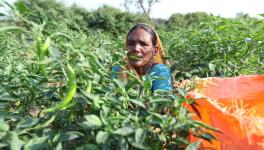Crops in 80 Mizoram Villages Damaged by Fall Armyworm Outbreak

Image Courtesy: The Indian Express
New Delhi: Crops of over 80 villages in Mizoram have been affected by Fall Armyworm attack. Fall Armyworms (FAWs), a dangerous crop damaging pest, has created fear among the farmers who constitute more than 70% of the total population of this highly agriculture dependent state in the North Eastern region. Maize and paddy are the two major crops in the hilly state and has nearly 5,900 hectares with maize cultivation at present.
The farmers fear that the infestation might lead to a famine-like situation that Mizoram had witnessed six decades ago, according to a report in Northeast Today. In 1958-59, Mizoram had been affected by massive rodent attack on its crops following mautam or large-scale bamboo flowering. More than 100 people had lost their lives in the famine-like situation that followed the destruction of crops in the rodent attacks.
Mizoram was a part of Assam then, but the state government’s inability to tackle the situation led to the formation of Mizo National Famine Front and later Mizo National Front (MNF). Led by the rebel leader Laldenga, MNF in 1966 declared secession from India. In 1972, it was carved out as a Union Territory, and later, on February 20, 1987, Mizoram became the 23rd state of India.
The state’s farmers have been gripped by the fear of a possible re-run of the situation. The state agriculture department has issued an alert across the state, as 1,409 hectares of maize cultivation has been severely damaged in all eight districts in the past one month, reported Deccan Herald. The damaged crops were worth Rs 18.4 crore.
Agriculture Director of the state, Rohmingthnaga Colney said at a press conference that the outbreak of FAWs was first reported on March 3 from Ngasih area in south Mizoram’s Lunglei district. The infestation spread in the entire state in less than a month’s time. Colney also said that at least 31 villages in Aizawl district, 10 each in Mamit, Serchhip and Lunglei districts, 6 in Champhai district, 5 in Kolsib district, and 4 each in Siaha and Lawngtlai districts have been affected by the outbreak, as per the report.
“Our farmers have been caught unawares as we have never witnessed fall armyworm attack unlike in other states. This could be due to long dry spell and sudden increase in temperature. Some villages have seen 100% damage of their crops and this has made them scared,” Joint Director of the Agriculture Department, James Lalsianliana told Deccan Herald.
According to Agriculture Department officials, joint teams of Agriculture Technology Management Authority and District Agricultural Offices have visited the affected villages, organising on-the-spot training and demonstration on how to prevent the infestation from spreading, and pesticides, insecticides, and sprayers have also been distributed to the maize farmers. The Centre have been informed of this outbreak, and the state agricultural experts have also consulted scientists at Indian Council of Agricultural Research.
According to a report in magazine, Down to Earth, the up to 2-cm long Fall Armyworm pest “accidentally” landed in Africa in 2016 from the Americas, almost after 100 years. Since then, it has spread to over 50 countries in Africa and Asia ravaging crops, especially maize.
“In 2018, it invaded Asia through Yemen and India and has now spread to Bangladesh, Myanmar, Nepal and China,” said the report, adding that the “rapid breeder, the insect is known to eat 300 species of plants, most of which are major food crops.”
Get the latest reports & analysis with people's perspective on Protests, movements & deep analytical videos, discussions of the current affairs in your Telegram app. Subscribe to NewsClick's Telegram channel & get Real-Time updates on stories, as they get published on our website.
























